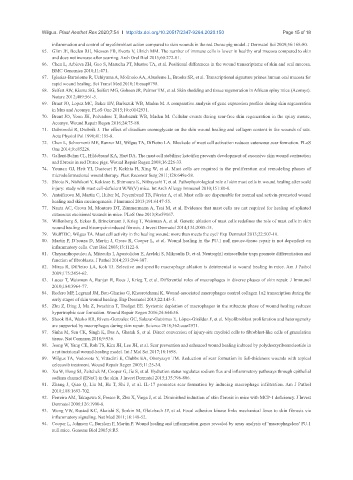Page 636 - Read Online
P. 636
Wilgus. Plast Aesthet Res 2020;7:54 I http://dx.doi.org/10.20517/2347-9264.2020.150 Page 15 of 18
inflammation and control of myofibroblast action compared to skin wounds in the red Duroc pig model. J Dermatol Sci 2009;56:168-80.
65. Glim JE, Beelen RH, Niessen FB, Everts V, Ulrich MM. The number of immune cells is lower in healthy oral mucosa compared to skin
and does not increase after scarring. Arch Oral Biol 2015;60:272-81.
66. Chen L, Arbieva ZH, Guo S, Marucha PT, Mustoe TA, et al. Positional differences in the wound transcriptome of skin and oral mucosa.
BMC Genomics 2010;11:471.
67. Iglesias-Bartolome R, Uchiyama A, Molinolo AA, Abusleme L, Brooks SR, et al. Transcriptional signature primes human oral mucosa for
rapid wound healing. Sci Transl Med 2018;10:eaap8798.
68. Seifert AW, Kiama SG, Seifert MG, Goheen JR, Palmer TM, et al. Skin shedding and tissue regeneration in African spiny mice (Acomys).
Nature 2012;489:561-5.
69. Brant JO, Lopez MC, Baker HV, Barbazuk WB, Maden M. A comparative analysis of gene expression profiles during skin regeneration
in Mus and Acomys. PLoS One 2015;10:e0142931.
70. Brant JO, Yoon JH, Polvadore T, Barbazuk WB, Maden M. Cellular events during scar-free skin regeneration in the spiny mouse,
Acomys. Wound Repair Regen 2016;24:75-88.
71. Dabrowski R, Drobnik J. The effect of disodium cromoglycate on the skin wound healing and collagen content in the wounds of rats.
Acta Physiol Pol 1990;41:195-8.
72. Chen L, Schrementi ME, Ranzer MJ, Wilgus TA, DiPietro LA. Blockade of mast cell activation reduces cutaneous scar formation. PLoS
One 2014;9:e85226.
73. Gallant-Behm CL, Hildebrand KA, Hart DA. The mast cell stabilizer ketotifen prevents development of excessive skin wound contraction
and fibrosis in red Duroc pigs. Wound Repair Regen 2008;16:226-33.
74. Younan GJ, Heit YI, Dastouri P, Kekhia H, Xing W, et al. Mast cells are required in the proliferation and remodeling phases of
microdeformational wound therapy. Plast Reconstr Surg 2011;128:649e-58.
75. Shiota N, Nishikori Y, Kakizoe E, Shimoura K, Niibayashi T, et al. Pathophysiological role of skin mast cells in wound healing after scald
injury: study with mast cell-deficient W/W(V) mice. Int Arch Allergy Immunol 2010;151:80-8.
76. Antsiferova M, Martin C, Huber M, Feyerabend TB, Förster A, et al. Mast cells are dispensable for normal and activin-promoted wound
healing and skin carcinogenesis. J Immunol 2013;191:6147-55.
77. Nauta AC, Grova M, Montoro DT, Zimmermann A, Tsai M, et al. Evidence that mast cells are not required for healing of splinted
cutaneous excisional wounds in mice. PLoS One 2013;8:e59167.
78. Willenborg S, Eckes B, Brinckmann J, Krieg T, Waisman A, et al. Genetic ablation of mast cells redefines the role of mast cells in skin
wound healing and bleomycin-induced fibrosis. J Invest Dermatol 2014;134:2005-15.
79. Wulff BC, Wilgus TA. Mast cell activity in the healing wound: more than meets the eye? Exp Dermatol 2013;22:507-10.
80. Martin P, D’souza D, Martin J, Grose R, Cooper L, et al. Wound healing in the PU.1 null mouse-tissue repair is not dependent on
inflammatory cells. Curr Biol 2003;13:1122-8.
81. Chrysanthopoulou A, Mitroulis I, Apostolidou E, Arelaki S, Mikroulis D, et al. Neutrophil extracellular traps promote differentiation and
function of fibroblasts. J Pathol 2014;233:294-307.
82. Mirza R, DiPietro LA, Koh TJ. Selective and specific macrophage ablation is detrimental to wound healing in mice. Am J Pathol
2009;175:2454-62.
83. Lucas T, Waisman A, Ranjan R, Roes J, Krieg T, et al. Differential roles of macrophages in diverse phases of skin repair. J Immunol
2010;184:3964-77.
84. Rodero MP, Legrand JM, Bou-Gharios G, Khosrotehrani K. Wound-associated macrophages control collagen 1α2 transcription during the
early stages of skin wound healing. Exp Dermatol 2013;22:143-5.
85. Zhu Z, Ding J, Ma Z, Iwashina T, Tredget EE. Systemic depletion of macrophages in the subacute phase of wound healing reduces
hypertrophic scar formation. Wound Repair Regen 2016;24:644-56.
86. Shook BA, Wasko RR, Rivera-Gonzalez GC, Salazar-Gatzimas E, López-Giráldez F, et al. Myofibroblast proliferation and heterogeneity
are supported by macrophages during skin repair. Science 2018;362:eaar2971.
87. Sinha M, Sen CK, Singh K, Das A, Ghatak S, et al. Direct conversion of injury-site myeloid cells to fibroblast-like cells of granulation
tissue. Nat Commun 2018;9:936.
88. Jeong W, Yang CE, Roh TS, Kim JH, Lee JH, et al. Scar prevention and enhanced wound healing induced by polydeoxyribonucleotide in
a rat incisional wound-healing model. Int J Mol Sci 2017;18:1698.
89. Wilgus TA, Vodovotz Y, Vittadini E, Clubbs EA, Oberyszyn TM. Reduction of scar formation in full-thickness wounds with topical
celecoxib treatment. Wound Repair Regen 2003;11:25-34.
90. Xu W, Hong SJ, Zeitchek M, Cooper G, Jia S, et al. Hydration status regulates sodium flux and inflammatory pathways through epithelial
sodium channel (ENaC) in the skin. J Invest Dermatol 2015;135:796-806.
91. Zhang J, Qiao Q, Liu M, He T, Shi J, et al. IL-17 promotes scar formation by inducing macrophage infiltration. Am J Pathol
2018;188:1693-702.
92. Ferreira AM, Takagawa S, Fresco R, Zhu X, Varga J, et al. Diminished induction of skin fibrosis in mice with MCP-1 deficiency. J Invest
Dermatol 2006;126:1900-8.
93. Wong VW, Rustad KC, Akaishi S, Sorkin M, Glotzbach JP, et al. Focal adhesion kinase links mechanical force to skin fibrosis via
inflammatory signaling. Nat Med 2011;18:148-52.
94. Cooper L, Johnson C, Burslem F, Martin P. Wound healing and inflammation genes revealed by array analysis of ‘macrophageless’ PU.1
null mice. Genome Biol 2005;6:R5.

